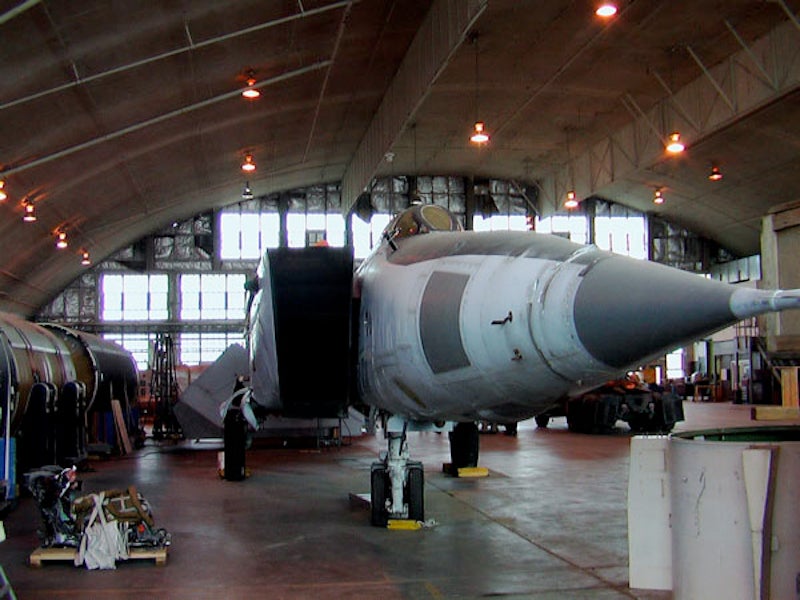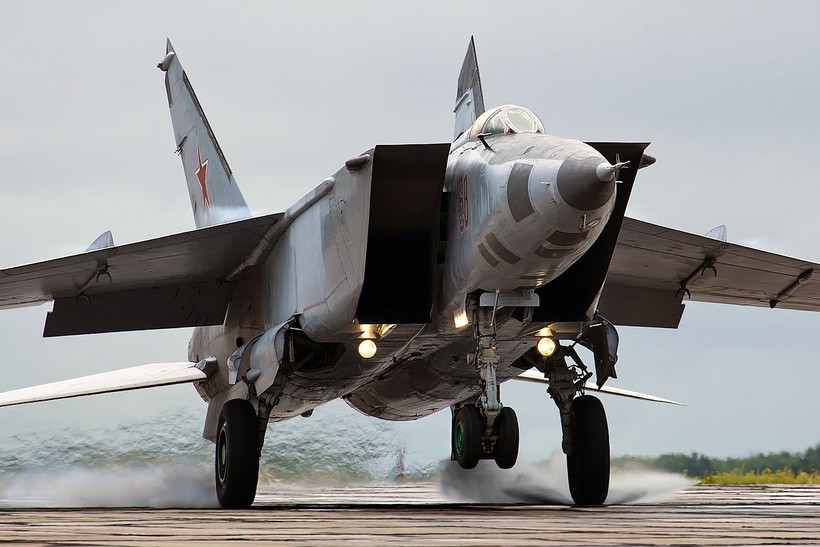
The Mikoyan-Gurevich (MiG)-25P is a supersonic interceptor and reconnaissance aircraft for countering air targets in all weather conditions, by day and by night, and in dense hostile electronic warfare environments. The MiG-25P constitutes a part of the Russian S-155P missile interceptor system.
MiG-25P was produced by RSK MiG, which is based in Moscow, and the Sokol Aircraft Manufacturing Plant Joint Stock Company at Nizhni Novgorod in Russia. The MiG-25 fighter series are known by the NATO codename Foxbat and served the air forces of Russia, Ukraine, Kazakhstan, Azerbaijan, India and Iraq. It is currently operated by the Algerian Air Force, Syrian Air Force and Libyan Air Force.
The MiG-25 is one of the fastest combat aircraft ever produced, capable of achieving speeds in excess of Mach 2.83. Production ended in 1984.
MiG-25P aircraft design
MiG-25P is a twin-finned, high-wing monoplane with slightly swept wings and a variable-angle tail plane. To improve the aircraft’s longitudinal stability, and to avert stall at steep angles and subsonic speed, there are two shallow upper-surface fences on each wing.
The high-wing monoplane configuration together with lateral air intakes have the effect of reducing the loss of aerodynamic efficiency resulting from wing-fuselage interference.
High-strength steels and titanium are used in approximately 80% of the MiG-25 airframe.
Weapons
The MiG-25P aircraft is armed with four R-40 (Nato codename AA-6 Acrid) air-to-air missiles equipped with infrared and radar homing heads. The range of these missiles is 2-60km.The missiles are suspended from four underwing pylons. It may also be fitted with two R-40 and four R-60 (AA-8 Aphid), or two R-23 (AA-Apex) and four R-73 (AA-11 Archer). The MiG-25 is not fitted with a gun.
Avionics on-board MiG-25P
MiG-25P is fitted with electronic equipment including: Smerch-A2 radar sight (Nato codename Fox Fire), developed by the Phazotron Research and Production Company; Identification Friend or Foe (IFF) transponder; aircraft responder to maintain communications with guidance and landing radars operating in active radio-location mode; and radar warning receiver.The flight control and navigation equipment includes ARK-10 automatic radio compass, RV-4 radio altimeter and Polyot-11 navigation-landing system.The Polyot-11 navigation and landing system, coupled with ground radio beacon and landing radio beacons, provides programmed aircraft manoeuvres including climb, en-route flight, returns to the take-off aerodrome or to one of the three emergency airfields, and low-run landing approach and missed approach manoeuvres.
Engines
MiG-25P aircraft is powered by two R-15B-300 single-shaft turbojets, arranged in the tail section of the fuselage. The engines develop 11,200kgf of thrust with fully selected afterburner. The engines provide a maximum speed of 3,000km/hour at high altitude.
The maximum speed at low altitude is 1,200km/hour. The aircraft has a service ceiling of 22,500 metres. The range at altitudes between 9-11km with speed of Mach 0.85 is 1,950km. At higher altitudes between 20-21km and speed Mach 2.35, the range is 1,650km. The maximum in-service g-load is 4.5g.
MIG-25 variants
MiG-25R, MiG-25RB and MiG-25BM are derivatives from the MiG-25P. The MiG-25R is a tactical reconnaissance aircraft. The MiG-25RB is a variant for bombing area and large targets.
The aircraft is fitted with a reconnaissance station, aerial camera, topographic aerial camera, the Peteng sighting and navigation system to bomb programmed targets, and electronic countermeasures (ECM) equipment, which includes active jamming and electronic reconnaissance systems.
The MiG-25BM aircraft has the capability to launch guided missiles against ground targets, and to destroy area targets, targets with known co-ordinates, and enemy radars.The airborne anti-radar Kh-58 (Nato codename AS-11 Kilter) missiles are capable of destroying enemy radars, such as the targeting radars of Hawk-type air defence missile systems, at stand-off ranges.The launch range of the Kh-58 is from 40-300km. The Kh-58U missile is developed and manufactured by the Raduga Engineering Design Bureau, Moscow.
